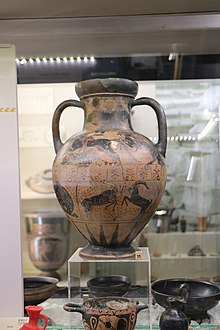Etruscan amphora showing Troilos


The Ure Museum's Etruscan amphora showing Troilos is a mid to late 6th century black-figure terracotta amphora of the 'Pontic' type[1] attributed to the Tityos Painter.[2] The main decoration is a depiction of the ambush of the Trojan Troilos by the Greek hero Achilles.
Decoration
[edit]Both sides of the neck of the amphora feature demi-Gorgons. The upper half of the main body depicts the ambush of the Trojan prince Troilos by the Greek hero Achilles, with the two sides depicting differing scenes of the event.[2]
One side has Achilles seizing Troilos outside the well-house, or, as Professor Percy Ure suggested,[3] carrying him to the shrine. Achilles is shown fully armoured – with ornate crested helmet, cuirass and greaves – while Troilos appears almost completely undressed.
The other side has two riders and an unmounted horse passing a fallen man. The lead rider next to the unmanned horse and above the fallen man is shown armoured with helmet and cuirass; the second rider and fallen man are clothed in a Thracian style, with soft caps and patterned cloaks.[3] Ure believed this to be an illustration of Achilles's attack on Troilos, with the following rider coming to Troilos's aid.[3]
It has been suggested that the changes to the normal Greek telling of the story, for example the lack of a depiction of Polyxena, by the Etruscan decorator may be a muddling of the tale as it travelled to Etruria or even a deliberate change to better suit local tastes.[3]
The lower half of the amphora is decorated with wild animals: two male goats on their hind legs (as if rutting), two lions (one licking its paw) and a winged humanoid.[1]
The middle of the amphora features a band of palmettes, and the base a simple geometric triangle pattern.[1]
Both Ure and Professor Brian Sparkes noted that it is the rarity of the amphora opposed to its quality that marks it as an important example of the 'Pontic' type.[3][1]
Acquisition
[edit]Ure acquired the amphora for the museum, then the Museum of Greek Archaeology, at auction in London in 1947.[3] Then, as now, very little was known of the amphora's provenance. It is thought to originate from the Etruscan city of Vulci, north-west of Rome – Ure noted that the scene of Achilles' ambush of Troilos was a popular one for decorating tombs in the area.[1] A poorly written description in the auction catalogue enabled Ure,[3] after seeking advice from Sir John Beazley, to acquire it at a relatively economic price.
Current display
[edit]
The amphora is now on permanent display at the Ure Museum. It is one of the more prominent items in the museum's large collection, and is a popular attraction for both scholars and members of the general public.
References
[edit]- ^ a b c d e Ure, P N (1951). "A New Pontic Amphora". The Journal of Hellenic Studies. 71: 198–202. doi:10.2307/628202. JSTOR 628202. S2CID 163606144.
- ^ a b "Ure Museum | Database". uredb.reading.ac.uk. Retrieved 2019-09-11.[permanent dead link]
- ^ a b c d e f g Sparkes, Brian (2006). "Troilos in Tuscany" (PDF). Ure Museum of Greek Archaeology. Retrieved 2019-09-11.
Further reading
[edit]- http://uredb.reading.ac.uk/cgi-bin/ure/uredb.cgi?rec=47.6.1[permanent dead link]
- PN Ure, 'A New Pontic Amphora', The Journal of Hellenic Studies, Vol 71 (The Society for the Promotion of Hellenic Studies, 1951) doi:10.2307/628202
- Brian Sparkes, 'Troilos in Tuscany' (2006)

